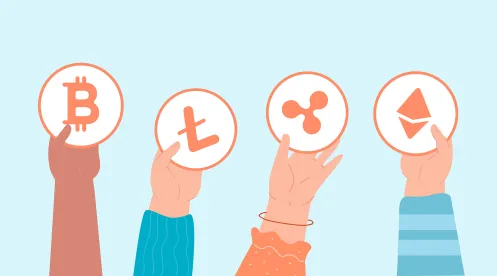Just barely two weeks ago, we wrote about the half-victory for Ripple Labs in its ongoing litigation with the Securities and Exchange Commission (“SEC”), in which Judge Analisa Torres granted partial summary judgment in favor of Ripple on the issue of whether certain sales of Ripple’s XRP cryptocurrency tokens were “securities” under the federal securities laws. Some in the crypto industry interpreted her ruling to mean that secondary transactions in crypto assets on centralized and decentralized crypto exchanges were not transactions in “securities,” even though Judge Torres expressly declined to address the secondary trading issue. Fast forward to today, and a new ruling out of the SDNY against Terraform Labs casts further doubt on this interpretation.
Ripple Recap
In her ruling on the status of XRP tokens as “investment contracts,” Judge Torres concluded that under Howey certain sales of XRP tokens to institutional investors met the definition of “investment contracts,” while programmatic sales to individuals and retail investors via digital currency exchanges did not meet the same definition. Judge Torres’s decision hinged on how the XRP tokens were sold and what Ripple itself disclosed to purchasers of the tokens. While Ripple gave fulsome disclosures to institutional investors and as such, those individuals understood that purchasing XRP was investing in Ripple, retail investors purchasing XRP on the secondary market did not receive similar disclosures and were thus unaware they were buying XRP from Ripple, let alone investing in Ripple. The Ripple court determined that this difference in the nature of the transaction—and the buyer’s understanding in a particular transaction—drove the analysis of whether or not the XRP token sales at issue were “investment contracts” and thus “securities.”
As we noted, the court’s decision created an awkward dynamic favoring applying the protections of the federal securities laws to institutional investors, but not retail investors. We also highlighted that if other courts were to adopt Judge Torres’s reasoning, the critical factor in deciding whether a token is a security would be how that token is sold. Our key takeaway was that the split decision left both the SEC and the crypto industry in a tenuous holding pattern given the court’s focus on the nature of the transaction and the identity of the buyer, and the uncertainty concerning whether other judges faced with the same question would adopt Judge Torres’s reasoning.
Terraform Decision
Within two weeks, a different judge within the Southern District of New York (this time, Judge Jed Rakoff) confronted a similar question, but came to a very different conclusion. In SEC v. Terraform Labs Pte. Ltd. and Do Hyeong Kwon, the defendants moved to dismiss the SEC’s complaint arguing that the cryptocurrency tokens Terraform Labs (“Terraform) developed and sold were not “investment contracts” (and thus “securities”) under the Howey test. According to the defendants, Judge Torres’s decision in Ripple was “fatal” to the SEC’s case that Terraform’s digital assets were sold as investment contracts. But Judge Rakoff disagreed, emphatically rejecting the ruling in Ripple and Judge Torres’s application of the Howey test. Judge Rakoff concluded that, at the Rule 12 stage, the SEC had met its burden of alleging that the tokens qualified as securities.
In Terraform, the SEC challenged Terraform’s sale of crypto assets (including its UST Coin) to investors in the United States. Terraform is a South Korean-based blockchain project that created a peer-to-peer payment network that also supported other decentralized applications. Terraform’s network depended on a suite of “stablecoins,” or crypto assets whose value is pegged to another asset, such as the U.S. dollar, to serve as a “useful medium[] of exchange” based upon its stable value compared to other, volatile crypto assets. Unlike a “traditional” stablecoin that is pegged directly the value of a real world asset, Terraform created a stablecoin, the UST Coin, which was indirectly pegged to the U.S. dollar by algorithms. The SEC alleged that Terraform marketed the UST Coins to investors as stable investments that would retain their value in perpetuity given they were pegged to the USD. The UST Coins then conferred a right to purchase Terraform’s LUNA Coins to investors. Ultimately, while UST Coins were supposed to maintain a 1:1 peg to the value of the USD, the UST Coins lost their peg because they artificially derived their value through an algorithmic pairing with the LUNA Coins.
According to the SEC’s allegations, Terraform also launched in April 2019 a blockchain to house transactions using the UST Coin and other crypto assets the company developed, but the market demand for these coins did not develop fast enough. In response, Terraform allegedly began a concerted marketing effort in September 2020 for UST Coins as “profitable investment opportunities.” Terraform directed these efforts at US investors and at investment conferences in the US, as well as on social media. Terraform also created the “Anchor Protocol,” an investment pool in which owners of UST coins would deposit their coins and “earn a share of whatever profits the pool generated.” By doing so, and by advertising potential return of 19-20% for investors, Terraform allegedly boosted the demand for UST Coins. Terraform also represented to investors that the continued profitability of UST Coins and the Anchor Protocol was dependent on the continued development of the “broader Terraform ‘ecosystem,’” which required maximizing the total volume of transactions processed on the blockchain.
At bottom, according to the SEC’s allegations, Terraform allegedly offered and sold these assets via unregistered transactions to both institutional and retail investors, and imposed no restrictions on the resale of certain crypto assets with the understanding that the tokens “would be resold to the public.” The SEC also alleged Terraform violated the federal securities laws simply by “directly offering and selling” certain tokens and other assets on “crypto-asset marketplaces.” Lastly, the SEC alleged that Terraform defrauded investors by representing that its Coins were “stable” investments that would always retain their value, yet took steps unbeknownst to investors to artificially prop up the value of the stablecoins to preserve their value. These actions allegedly “restored confidence” in the Terraform marketplace and caused investors to invest billions of dollars into transactions on the ecosystem, only for the market for UST coins to collapse one year later (in May 2022), wiping out nearly $40 billion of total market value.
The SEC alleged that the above activity constituted violations of the antifraud provisions of the 1933 Act and the 1934 Act (along with Rule 10b-5), and separately, that Terraform’s failure to register the offer and sale of its crypto-assets separately violated the 1933 Act’s requirement to register such offerings.
It should be noted that the Court here was considering the defendants’ motion to dismiss, and as such, the defendants had a particularly high burden to meet under Rule 12 (in contrast to the Ripple court’s decision on summary judgment). Here, Judge Rakoff weighed the defendants’ motion to dismiss and uniformly rejected all grounds on which it moved. Most critically for the crypto industry writ large, the Court determined that the SEC pled a plausible claim that Terraform’s crypto assets (including UST Coins and LUNA Coins) were “securities” under the Howey test for investment contracts. The Court’s decision accepted all of the SEC’s allegations as true for purposes of the motion, and thus focused on the full set of facts and circumstances governing the transactions in Terraform’s crypto assets, and in so doing, rejected the Company’s suggestion to separately analyze whether the coins themselves were “securities” and then whether the investment protocols were as well.
The Court noted that the original UST Coins and LUNA coins “might not then have been, by themselves, investment contracts,” and that “where a stablecoin is designed exclusively to maintain a one to-one peg with another asset, there is no reasonable basis for expecting that the tokens -- if used as stable stores of value or mirrored shares traded on public stock exchanges -- would generate profits through a common enterprise.” But in the case of the UST and LUNA Coins, Judge Rakoff concluded that the circumstances around both tokens changed over time such that it would be inappropriate to erect artificial barriers between the coins and the investment protocols.
The Court next determined that according to the SEC’s allegations, Terraform’s crypto assets, taken together, met the element of a “common enterprise” under Howey. In sum, the Court found that the SEC met its burden by establishing the various crypto assets (UST Coins, LUNA Coins, and others) were allegedly either: (1) pooled together in the various investment protocols for the purposes of collective management by Terraform, whose managerial efforts created an expectation of profit generation that would then be redistributed to the individuals who had deposited their tokens in the protocol; or (2) sold to generate proceeds that would be used to develop Terraform’s blockchain further, which would increase the value of the tokens sold.
Lastly, the Court determined that if the SEC’s allegations were true, Terraform’s actions created a reasonable expectation of profits in its customers (the 3rd prong of the Howey test). Put another way, the SEC met its burden of alleging that a reasonable investor would believe profits would flow to it from their investment in Terraform’s crypto assets. The SEC met its burden through its allegations regarding Terraform’s marketing of the potential profitability of the Anchor Protocol or the future investment returns from Terraform’s use of proceeds from the sale of the LUNA Coins to “further develop[] the Terraform ecosystem.” In short, the SEC properly alleged that Terraform “held out to the coins’ consumers the possibility of profiting from their purchases,” which was sufficient to meet the 3rd Howey prong.
Indeed, the most newsworthy part of the Court’s opinion was Judge Rakoff’s emphatic rejection of the applicability of the Ripple decision. The Court noted that it “rejects the approach recently adopted by another judge of this District in a similar case” and declined to “draw a distinction between these coins based on their manner of sale” as Terraform argued it should. Judge Rakoff noted that the Ripple court’s distinction between institutional purchasers and retail investors purchasing on digital exchanges was wrong because “Howey makes no such distinction between purchasers,” and for good reason—because whether the distinction of whether a purchaser “bought directly from the defendants or . . . in a secondary re-sale transaction has no impact on whether a reasonable individual would objectively view the defendants’ actions and statements as evincing a promise of profits based on their efforts.” According to the Court, Terraform customers, regardless of their method of purchase, would have learned about Terraform’s representations regarding the use of proceeds from sales of Terraform coins to generate additional profits for all asset holders. All Terraform customers, therefore, had “every bit as good a reason to believe that [Terraform] would take their capital contributions and use it to generate profits on their behalf.”
The Court also denied dismissal on the other grounds Terraform raised, namely:
-
The Court determined that it had personal jurisdiction over Terraform. Using a 2022 decision from the Second Circuit in a related SEC case against Terraform as the baseline, the Court determined Terraform had extensive contacts with the US, marketed and promoted sales to US customers, entered into agreements to sell crypto assets to US trading firms, and met with US investors at US-based conferences.
-
The Court rejected Terraform’s argument that various statutory interpretation doctrines (for example, the Major Questions Doctrine) and the Administrative Procedure Act prohibited the SEC from alleging Terraform’s digital assets were “securities” under the federal securities laws. In particular, the Court (much like the Court in Ripple) rejected Terraform’s argument that the SEC’s decision to regulate crypto assets as securities violated the Due Process Clause and the APA because crypto companies did not have fair notice of the SEC’s intention to do so. The Court noted that rather than paint all crypto assets as securities, it was sufficient that the SEC has consistently asserted that some crypto assets may be securities “depending upon their particular characteristics.”
Final Thoughts
While Judge Rakoff’s decision in Terraform does not disturb the contrasting decision of Judge Torres in Ripple, it does create an internal split among the judges of the SDNY and, more importantly, significantly more uncertainty for crypto companies and the SEC moving forward. The SEC, in responding to Terraform’s request for supplemental briefing regarding the Ripple decision, argued that Judge Torres’s decision “conflicts with and adds baseless requirements to Howey and its progeny.” The SEC also called the Ripple decision “wrongly decided” as to the distinction between sales to institutional investors and programmatic sales. As to the internal split within the judges of the SDNY, the SEC noted in the same filing that it was “considering the various available avenues for further review” of the Ripple decision and “intend[ed] to recommend that the SEC seek such review,” thereby indicating it would appeal the decision to the Second Circuit. It is too early to know whether Terraform’s attorneys intend to seek interlocutory review of the Court’s denial of the motion to dismiss. Regardless, the SEC, regulators, and crypto markets can likely expect the Second Circuit to weigh in on the application of Howey and whether crypto asset sales constitute an “investment contract” (at least with respect to the XRP tokens sold by Ripple) at some point in 2024.
Given the differing opinions of the judges in these cases at different stages of litigation, and the likelihood that the facts and circumstances of each crypto asset and offering will dictate applicability of the federal securities laws, the only likely way to ensure uniformity and certainty for the industry moving forward will be an act of Congress. Clearly the Ripple decision did not have that effect, nor (likely) will the Terraform decision. Yet some congressional momentum has started to gather, with the House Financial Services Committee recently advancing a bipartisan bill out of committee aimed at: (1) clearly defining when crypto assets qualify as securities under the federal laws; (2) expanding the Commodity Futures Trading Commission’s scope of regulatory authority over the crypto industry; and (3) clarifying the SEC’s scope of authority over the industry. It is too early to know whether such a bill could pass a divided Congress, let alone be signed by the Biden Administration. Yet until Congress acts, the question of when and how a digital asset becomes a “security” subject to the federal securities laws and requiring registration remains far from settled.







 />i
/>i

